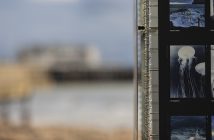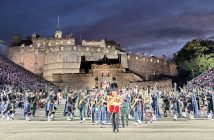This event occurred not long after reports circulated of Dennis being found wandering in a Mexican jungle, on location for a German film called Euer Weg Führt durch die Hölle — released as Jungle Fever – stark naked, and apparently trying to raise an army for the Third World War. He was detained by local police, declaring himself to be a “prisoner of war” and giving no personal details beyond his social security number. A period of detoxification followed.
VISITING DENNIS
In the mid-nineties I was collaborating on a book with David Hockney (Hockney on Art, Little, Brown, 2000) and we drove from David’s studio just off Mullholland Drive, down to the coast to Venice for dinner with Dennis, accompanied by Hockney’s two daschunds propped up in the back seat. In the meanwhile that corrugated fortress of a house, designed now with even more jagged extensions by Frank Gehry, was once more packed full of contemporary art, much of it vast in scale. As the living quarters resembled an aircraft hanger with steel girders and tubular walkways running all around us, this new-ish collection fitted the décor like a glove. There were works by David Sale, Julian Schnabel, Jean-Michel Basquiat, Keith Hering, and an installation by Jenny Holzer which consisted of a running statement in racing neon lights, like illuminated newsflashes in Times Square, reading, “You are so complex, you don’t respond to danger”, or something along these lines. Dinner was great; various personal assistants drifted around and about us, and I really can’t remember which if any current wife was in evidence. Come to think of it they weren’t usually at dinner, which demanded more mental than physical agility of Dennis and his guests. We had a wide-ranging conversation, mainly on art-related subjects, with a few scurrilous stories (decidedly not for publication) about friends and especially rivals. Dennis and David loved gossip, so we had lots of that.
During the meal I noticed what seemed like a portrait of Dennis hanging inconspicuously on the kitchen wall, half hidden by a cupboard. It appeared to be comprised of shattered shards of porcelain. I asked Dennis what it was and who had done it? “Julian Schnabel,” came his reply, “He made it out of the broken crockery on the kitchen floor which my wife threw at me the other day!”
During dinner we had left David’s dogs downstairs in Dennis’ pride and joy, a newly equipped screening room. On the floor between audience seating and screen was an enormous carpet, consisting of a heavily piled, one-piece, dead-white expanse of alpacka. Perhaps you have by now guessed that during dinner one of the dear little creatures had delivered an enormous dump right in the middle of this priceless virgin white field. As we descended to take our leave, David was suitably horrified, gazing around wildly for some kind of solution: of course there was none, for this was an irreparably stained, once expensive but now decidedly ex-carpet. Dennis, without blinking, continued to show us to the door without even acknowledging the disaster, a gracious and immaculate host till the end. We stumbled out, and as David shooed the yelping offenders into the back of the car, turned to me and said mournfully, “Oh dear, do you think this marks the demise of my social life in Hollywood?”
FRIENDSHIP
If Dennis liked you, you were a friend for life. Fortunately he seemed to like me, as well as my work. For 20 years of us knowing each other, however, he was unaware that I was a painter as well as a photographer and filmmaker (three pillars of our lives which we had in common). During my two or three trips to LA every year, I had been working on paintings of vernacular architecture: diners, motels, “Randy’s Donuts” and the like. Three years ago, I called Dennis and asked if he would like to see them and within an hour he had driven from Venice to my studio in North Hollywood in his Jaguar XJ, Havana cigar in hand. He came in and looked at the paintings for 20 minutes without saying a word. Finally he said, “You never told me you were a painter”. I wasn’t sure how to reply to this, (“Well you never asked?”) but he hurried on, “They’re great, you should have a show, would you like to have a show here?” Within 48 hours he had introduced me to a top Santa Monica Gallery (Track 16 at Bergamot Station), a show was arranged and he had agreed to personally curate it. That’s the kind of friend Dennis was.
So how will history judge this outrider of the avant-garde, our gritty long-haired symbol of simpler times, roaring down highways and lonely deserts, both real and imagined? I would guess that he’ll take his rightful place in the pantheon of late 20th century American auteurs. Floating on the water of memory, long after his dust has settled, will remain a handful of great acting performances, some wonderful films as a director, three or four incredible art collections dissembled by disputing legatees, many loyal and devoted friends, the respect of his luckier colleagues and an unmatched body of work as a photographer.
My first reaction, after the initial shock of hearing of his death was to feel the irony that it was the old Hollywood he notoriously wanted to bury who ended up burying him. But Dennis, who came to love Hollywood old and new, had the last laugh. He is no longer with those vacillating Beverly Hillsians, for he took his bones to Taos, New Mexico. Spiritual (and physical) home to DH Lawrence, Ansel Adams, and Georgia O’Keefe, what better place is there for an artist to lay himself down? Rest easy, dear rider, for those who love you will surely be visiting again with you one day.
Paul Joyce is a filmmaker, photographer, artist and writer. He is the great-grand-nephew of James Joyce. Dennis Hopper appeared in a total of seven Lucida Productions (the production house set up by Paul Joyce) to the point that he was thought of as the company mascot:
Some Kind of Genius (1986)
Out of The Blue and into the Black (two parts) (1986)
Motion and Emotion: the Films of Wim Wenders (1989)
Pilgrim: The Life and Work of Kris Kristofferson (1992)
Dark and Deadly: Hollywood and Film Noir (1994)
Marlon Brando: Wild One (1996)
Mantrap: Sam Peckinpah and ‘Straw Dogs’ (2003)




